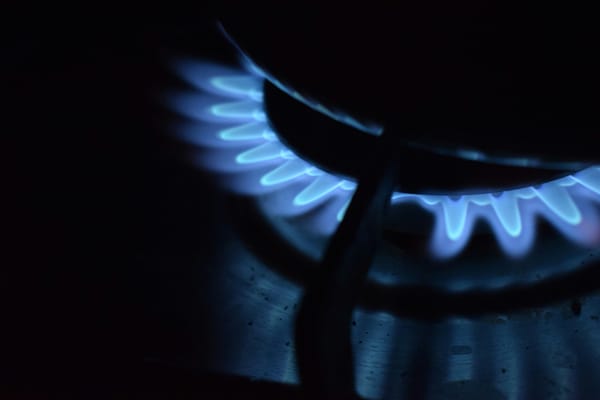Now you’re cooking with magnets

A few weeks ago, we rocked up to our friends' new place. The crew brought kai, congratulated them on the move, gave big hugs, got the tour.
For weeks, my friend and I had been planning to conduct an experiment. Immediately after exploring their new place, I asked "can I boil some water?"
Their cooktop is induction. It is powered by magnets. This innovative tech is turning preconceptions about electric cooking on its head. It's cheap to run, provides precise heat, and offers a speed even gas stoves can't compete with.
As we cut pollution out of our lives, the best of our restaurants will be cooking with magnets. If you have a gas stove, it could pay to switch.
Fossil fuel advertising has tried to add sex appeal to gas stoves, just like they did with smoking. Turns out gas stoves make people sick, just like cigarettes do.
Induction stoves have a magnetic appeal
We grabbed a pot and put some water on to boil. Our highly unscientific experiment: could induction really boil water twice as fast?
From start to finish, our cold pot of tap water boiled in just under 3 minutes. I couldn't help but laugh as the water started moving and bubbling way faster than usual.
Back at my house, I ran a similarly unscientific experiment on our regular electric stove. It took twice as long: 6 minutes.
There are so many reasons why cooking with magnets is sexy. The speed and quality of heat compared to a regular electric stove is enough for me to want to upgrade.
Better than that, induction stoves are 20-40% faster at heating than gas. Induction cooktops also don't stay hot for long. If you love your gas stove for that speed and precision, induction stoves are a big improvement in speed and safety. It's why some chefs in Aotearoa and abroad are beginning to choose magnetic cooking.
This is the beauty of low-pollution technology like solar panels and electric vehicles: they're so fun to use even if you don't care about the climate benefits.
New innovations also offer benefits beyond the obvious stuff. With a solar and battery system, you're not affected by blackouts. E-bikes help inactive people get more exercise than they would dream of on a regular bike. EVs keep our streets quieter than noisy combustion engines.
Induction stoves have similar extended benefits. Cooking with magnets is far more efficient than cooking with gas, saving people money on energy and gas lines charges. When homes leave the gas network, we can reserve a little more gas for industries that can't easily switch to electricity yet.
The biggest benefit of cooking with magnets, however, is in health. Gas stoves make many of us sick, especially our kids.

The invisible harm of gas
For over a century, there's been a fight over whether cooking with gas is safe.
Back in the 1980s, the US came very close to regulating gas stoves because they harmed human health. Gas companies lobbied hard and spread doubt. It got them out of being regulated.
Gas continued to market itself as the chef's choice. If you weren't "cooking with gas", you weren't really cooking. Even today, influencers are being paid by the gas industry to make gas stoves seem sexy and fun.
These tactics stink of the tobacco and oil industry. Advertise the hell out of your product to protect your business against growing evidence that it's harmful.
This issue boiled over in New Zealand recently when EECA released a new report into the deaths and sickness we can attribute to pollution in our homes.
According to their research, 208 New Zealanders die prematurely from gas stoves every single year. A similar number of people die prematurely because of stove pollution as those who died on our roads last year.
Worse than that, thousands of kids get asthma every year because of the pollutants that are spewed from gas stoves. The health of these kids is affected forever.
The gas lobby argued to Stuff that the problem isn't burning gas, but bad home ventilation. That feels like saying the real problem is keeping the windows closed when someone smokes in a car with kids.
Meanwhile, some health experts believe the estimates of premature death and asthma in this latest report are underestimating the harm.
Considering how expensive and harmful these machines can be, it's easy to understand why the gas industry has lobbied so hard to stick around.
The future is bright
For a long time, gas seemed like good technology for cooking. Now that induction beats gas on precision and speed, those trade-offs are not worth it.
If you look hard enough, there are awesome things trickling into society that will make us healthier, save us money, and protect us from a warming world, all while being really fun to use.
The hard part is the barrier to switching people. Some of the challenge is finance. Induction stoves cost more: about $1,000 to $2,000. A gas stove costs about $500 to $800. The upfront cost is worth it because they cost less to run, but can still be a barrier. Thankfully, green loans exist for homeowners to smooth out the cost. Renters face different barriers – they can't usually make these decisions themselves.
Induction tech also requires magnetic cookware. It might mean replacing some pots and pans. For those who need to buy new pots, that one-time cost is offset by years of cheaper power and healthier lives.
But the transition is also a problem of information and culture. If someone's stove breaks and they have no idea that induction stoves are faster, more precise, cheaper to run, and healthier, they might just pick the unhealthy and expensive option.
For decades, advertising has influenced our bias for gas cooking so much that "now you're cooking with gas" is English shorthand for "doing really well".
Gas stoves are not as good as their hype. They've been out-innovated by a product that's safer for kids. Truly sexy stovetops feel, and are, magnetic.
Getting more people considering induction stoves will take finance, persuasion, and some great marketing.
But once they start cooking with magnets, they'll never look back.





